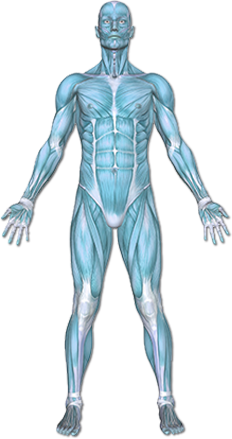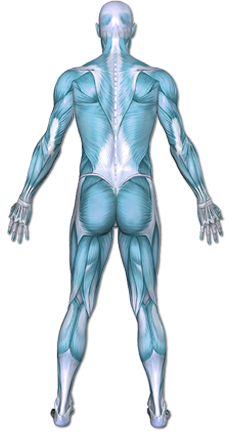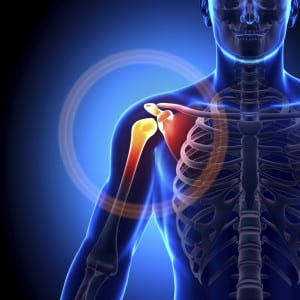Osteoarthritis of the Shoulder
Osteoarthritis is the breakdown of cartilage in the joints. This is followed by chronic inflammation of the joint lining. Healthy cartilage is a cushion between the bones in a joint. Osteoarthritis usually affects the hands, feet, spine, hips, and knees. People with osteoarthritis usually have joint pain and limited movement in the affected joint.
This content was created using EBSCO’s Health Library
The exact cause is unclear.
This content was created using EBSCO’s Health Library
Factors that may increase your chance of developing osteoarthritis include:
- Advancing age
- Excess body weight
- Family history of osteoarthritis
- Certain endocrine, metabolic, or neuropathic disorders, avascular necrosis
- Having an injury or surgery to the joint surface, especially the cartilage
- Having an occupation or doing physical activities that put stress on joints
This content was created using EBSCO’s Health Library
Osteoarthritis may cause:
- Mild-to-severe pain in a joint, especially after overuse or long periods of inactivity, such as sitting for a long time
- Creaking or grating sound in the joint
- Swelling, stiffness, limited movement of the joint, especially in the morning
- Deformity of the joint
This content was created using EBSCO’s Health Library
Your doctor will ask about your symptoms and medical history. A physical exam will be done.
Tests may include:
- X-ray to see internal body structures
- CT scan to look at the extent of the arthritis
- Arthrocentesis to rule out other causes of arthritis
- Blood tests to rule out other causes of arthritis
This content was created using EBSCO’s Health Library
The physical therapy treatment will likely be part of your conservative management program for osteoarthritis. The therapist will focus on maximizing the amount of safe motion that the shoulder can perform and provide education on how to alter your activities to stay within that motion. You will likely be provided with a home exercise program that includes strengthening the uninvolved muscle groups in order to provide support for those that are inflamed or damaged.
If you do need to have surgery, the therapist will follow a specific protocol for safe recovery. A surgery at the AC joint without rotator cuff repair may allow early motion within days of surgery, whereas a total shoulder arthroplasty with rotator cuff repair may prevent all active motion for weeks. The recovery may be uncomfortable but will not be based on the “no pain, no gain” principles because the tissues need time to heal. Pain often means more inflammation and is counterintuitive to health recovery. Be sure to do your home exercise program as instructed by the therapist in order to stay on track in your rehabilitation.
This content was created using EBSCO’s Health Library
To help reduce your chance of developing osteoarthritis, take these steps:
- Maintain a healthy weight.
- Do regular, gentle exercise, such as walking, stretching, swimming, or yoga.
- Avoid repetitive motions and risky activities that may contribute to joint injury, especially after age 40.
- With advancing age, certain activities may have to be stopped or modified. It is important to continue to be active, so find an activity that suits you.
This content was created using EBSCO’s Health Library
This content was created using EBSCO’s Health Library
RESOURCES:
- American College of Rheumatology
- The Arthritis Foundation
CANADIAN RESOURCES:
- The Arthritis Society
- Seniors Canada
REFERENCES:
- American College of Rheumatology Subcommittee on Osteoarthritis. Recommendations for the medical management of osteoarthritis of the hip and knee. 2000 update. Arthritis Rheum. 2000;43:1905-1915.
- Jordan K, Arden N, et al. EULAR recommendations 2003: an evidence based approach to the management of knee osteoarthritis: report of a task force of the Standing Committee for International Clinical Studies Including Therapeutic Trials (ESCISIT). Ann Rheum Dis. 2003;62:1145-1155.
- Osteoarthritis. Arthritis Foundation website. Available at: http://www.arthrit… . Accessed September 3, 2013.
- Osteoarthritis. National Institute of Arthritis and Musculoskeletal and Skin Disorders website. Available at: http://www.niams.nih.gov/Health_Info/Osteoarthritis/default.asp . Updated July 2010. Accessed September 3, 2013.
- Sinusas, K. Osteoarthritis: Diagnosis and treatment. Am Fam Physician. 2012;85(1):49-56.
- van den Berg WB. Pathophysiology of osteoarthritis. Joint Bone Spine. 2000;67:555-556.
- 10/21/2008 DynaMed’s Systematic Literature Surveillance https://dynamed.ebscohost.com/about/about-us Fransen M, McConnell S. Exercise for osteoarthritis of the knee. Cochrane Database Syst Rev. 2008;CD004376.
- 12/11/2009 DynaMed’s Systematic Literature Surveillance https://dynamed.ebscohost.com/about/about-us: Rutjes WJ, Nuesch E, Sterchi R, et al. Transcutaneous electrostimulation for osteoarthritis of the knee. Cochrane Database Syst Rev. 2009;(4):CD002823.
- 10/15/2010 DynaMed’s Systematic Literature Surveillance https://dynamed.ebscohost.com/about/about-us: Wandel S, Jüni P, Tendal B, et al. Effects of glucosamine, chondroitin, or placebo in patients with osteoarthritis of hip or knee: network meta-analysis. BMJ. 2010;341:c4675.
- 10/26/2010 DynaMed’s Systematic Literature Surveillance https://dynamed.ebscohost.com/about/about-us: Massey T, Derry S, Moore R, McQuay H. Topical NSAIDs for acute pain in adults. Cochrane Database Syst Rev. 2010;(6):CD007402.
- 11/15/2010 DynaMed’s Systematic Literature Surveillance https://dynamed.ebscohost.com/about/about-us: US Food and Drug Administration. FDA clears Cymbalta to treat chronic musculoskeletal pain. US Food and Drug Administration website. Available at: http://www.fda.gov… . Updated April 19, 2013. Accessed July 23, 2013.
This content was created using EBSCO’s Health Library



